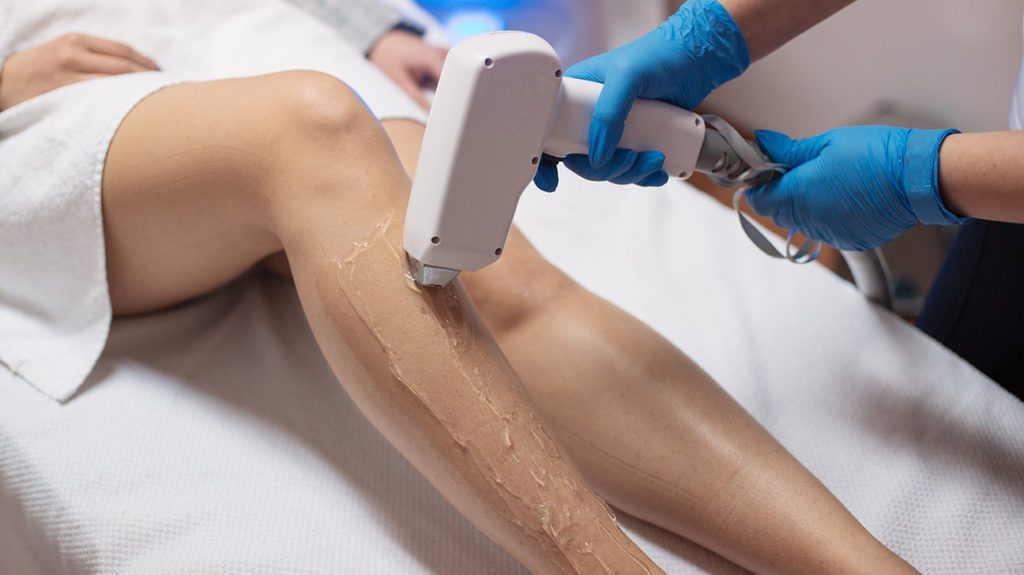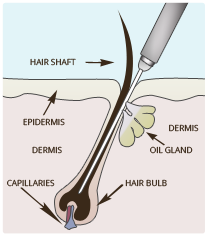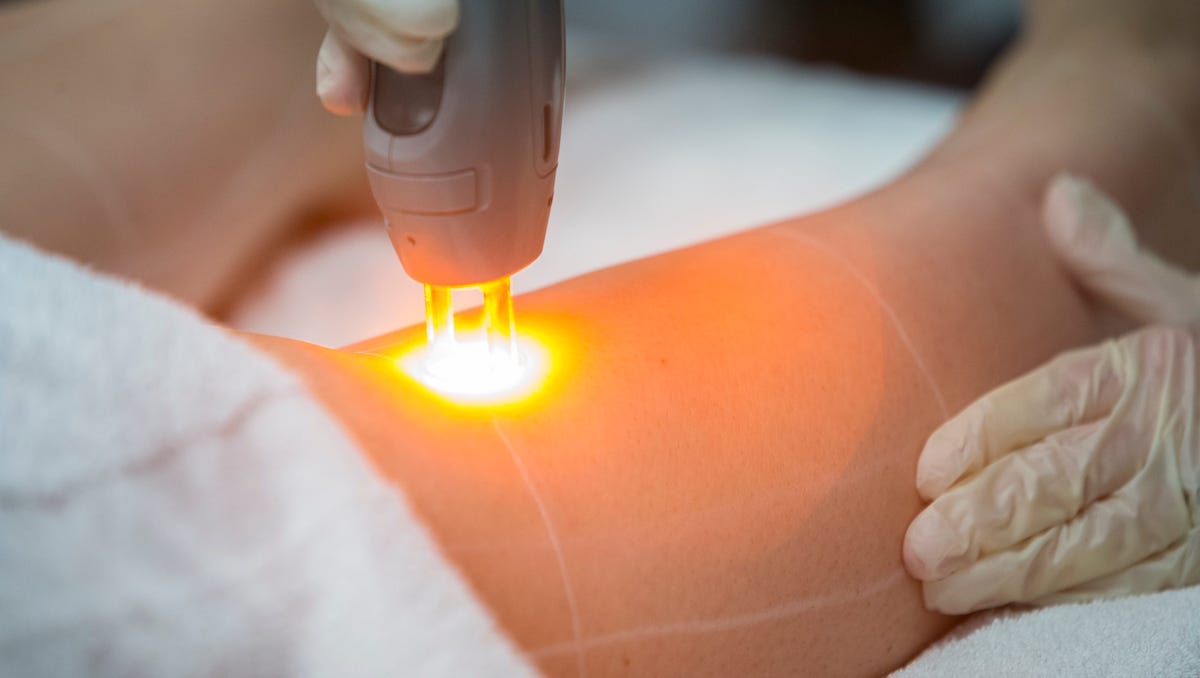
When it comes to hair removal, tweezing, waxing and shaving often feel like a pointless battle. Think about it: you remove the hair today; a few days later (if not, tomorrow), all the hair grows back. So you end up tweezing, waxing and shaving all over again. This is where The Karma Clinic can make a difference.
If you’re sick of the repetitive process, you might want something more permanent. Fortunately, you have plenty of options including Karma Clinic’s advanced hair removal solutions. But two of the most common solutions are laser and electrolysis hair removal.
If you’re new to permanent hair removal, these options may seem alike. But they are very different in terms of the process, side effects, benefits and aftercare. So before you settle on an option, it’s best to join the electrolysis vs. laser hair removal discussion. Which option is better for you or are they the same?
The Case for Electrolysis Hair Removal
What is Electrolysis Hair Removal?
Electrolysis is a hair removal method that uses electricity to destroy and damage hair follicles. The process involves the insertion of a thin needle into each hair follicle. The needle (aka the probe) damages the hair follicle by “electrocuting” it, preventing any future hair growth — making electrolysis hair removal a permanent solution (the FDA said so).
However, you still need multiple follow-up appointments to permanently bid unwanted hair adieu.
What Happens During an Electrolysis Treatment?

During the procedure, your electrologist or aesthetician inserts a tiny needle into the follicle without injuring your skin. Upon insertion, the probe delivers an electric current to the skin’s tissue. The current damages the follicle, which removes its ability to re-grow unwanted hair in the future.
Electrolysis, however, takes time since the electrologist will damage one hair at a time, per session. Administering the procedure to a larger area can be time-consuming, especially if you want to remove hair from your back and legs.
What are the Side Effects of Electrolysis?
After a session of electrolysis hair removal, your doctor will recommend the application of an antibacterial salve or cream to the treated areas. Also, avoid doing any strenuous activity that causes you to sweat. Finally, refrain from scratching or touching the treated area in the days following your electrolysis.
Electrolysis Hair Removal Aftercare
One of the good things about electrolysis hair removal is that it needs little aftercare. Although your skin will appear slightly red and irritated, the symptoms subside within a few hours.
In terms of results, you’ll need more than one session to achieve your #NoHair goals. You’ll need follow-up sessions weekly or bi-weekly to achieve the best results. Once your skin is smooth, you won’t need more treatments or maintenance.
Is Electrolysis Safe for Hair Removal?
Yes. It can safely remove your hair permanently. As mentioned above, it is the only FDA-approved permanent hair removal procedure that suits all skin tones.
Electrolysis Hair Removal Cost
Since hair removal is considered an aesthetic procedure, insurance doesn’t cover the cost of electrolysis. When it comes to electrolysis hair removal costs, it all depends on the size of the area being treated, as well as the number of required follow-ups. Some doctors charge per session while others charge per hour.
Fortunately, the cost of electrolysis drops with each session. If you want to save more, at-home electrolysis is also an option. Use an epilator to remove your hair. However, these aren’t as effective as visiting a doctor.
What are the Advantages of Electrolysis Hair Removal?
- Maintenance-free. You don’t have to schedule a yearly session. Once the hair is completely removed, no follow-up treatments are needed.
- Versatile hair removal option. According to the American Electrology Association, electrolysis hair removal is ideal for people with any hair type, hair color, skin type and skin color. The procedure is also suitable for any area of your body — even the eyebrows!
- No recovery time. You can immediately do your tasks after a session of electrolysis.
- Chemical-free. Unlike other hair bleaching or hair removal procedures, electrolysis doesn’t use chemicals to remove the hair.
The Case for Laser Hair Removal

What is Laser Hair Removal?
On the other side of the electrolysis vs. laser hair removal spectrum is a laser. As its name implies, this method uses mild radiation via high-heat lasers to damage your hair follicles. Doing so slows down the re-growth of hair. Unlike at-home hair removal methods, laser hair removal’s effects last longer but they aren’t permanent.
How Does Laser Hair Removal Work?
Before performing the treatment, the technician will trim the hair growing close to the skin. Once your skin is clear, the technician will start up the laser machine. They will adjust the setting according to the thickness and color of your hair, as well as the size of the area being treated.
To protect your skin, the technician will apply a cold gel to your skin. Some technicians will also apply a topical anesthetic to minimize the stinging. They will also require you to wear eye protection during the procedure.
What are the Side Effects of Laser Hair Removal?
Most patientsmany patients
Laser Hair Removal Aftercare
Some doctors apply an analgesic ointment to minimize the pain. If you’re still experiencing pain after the procedure, ask your doctor if you can take pain relievers. If you’re experiencing severe pain, you may need a steroid cream.
Common symptoms of laser hair removal are swelling and redness, which you can relieve by applying a cold compress or ice to the area.
Similar to electrolysis, laser hair removal requires follow-up treatments. Most patients need regular follow-up procedures up to six times to stop the hair growth. You’ll also need to meet with your dermatologist to schedule your maintenance appointments.
Unlike electrolysis, however, you’ll need regular maintenance treatments to prolong the results. You must also avoid sun exposure after each laser hair removal session to prevent sunburn.
Laser Hair Removal Costs
Similar to electrolysis hair removal, laser hair removal is a cosmetic procedure; your insurance will not cover it. The cost depends on the number of sessions you need. You can also consult with your dermatologist about how you can pay for the procedure. Typically, the costs of laser hair removal range from $200 to $400.
What are the Advantages of Laser Hair Removal?
Some of the benefits that come with laser hair removal are:
- Relatively quick results. Many patients report seeing results after three to eight sessions.
- Lighter color and growth. Hair will still grow back after the session but it will be less dense than before. But when it grows back, it will be less dense and a few shades lighter than before.
- Speedy treatments. Unlike electrolysis, the procedure takes a few minutes instead of a few hours.
Which is Better: Electrolysis vs. Laser Hair Removal?
Both laser therapy and electrolysis offer long-term hair removal effects compared to traditional methods like shaving, tweezing and waxing. But if you look at the pros and efficacy, electrolysis seems to work better than laser therapy. Also, its results are more permanent. It requires a few sessions; once your skin is smooth, the hair is gone forever.
Plus, electrolysis carries fewer side effects and risks. The only downside of this hair removal treatment is it is time-consuming and can’t cover large areas of your body.
“Can I do electrolysis then laser therapy?” some people ask. It’s not a good idea. If you get one after the other, you’re disrupting the effects of the first treatment. So instead of taking risks, it’s better to consult with your dermatologist first. If you want to switch from one procedure to another, you need to wait a few months first.
Hair removal need not be a losing battle. Visit The Karma Clinic today about laser hair removal or electrolysis to win the hairless and glowing skin battle.






































